Improving the Passenger Experience and the Role of Advanced Airport and Airline Handling Systems
Exceeding Expectations Creating the Future of Global Airports Winning the Battle Against Lost Luggage

The Battle for a Less Stressful Passenger Reducing the Wait
The Future of Baggage and People Management
TECHNICAL STUDY Published by Global Business Media
Switchboard: +44 (0)1737 850 939
Fax: +44 (0)1737 851 952
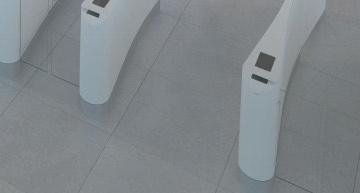

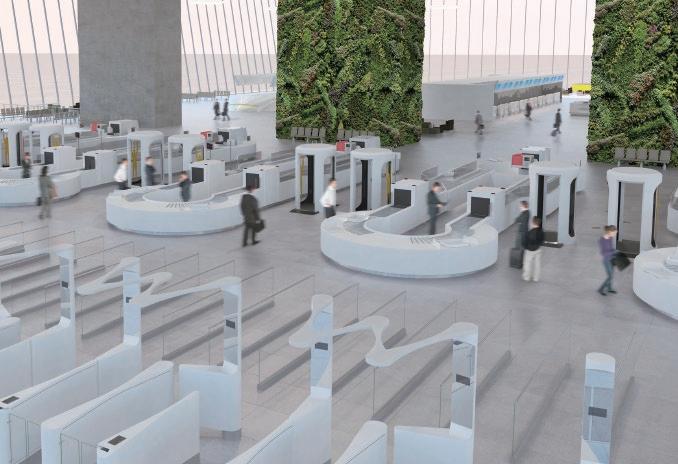
Email: info@globalbusinessmedia.org
Website: www.globalbusinessmedia.org
Publisher
Global Business Media


Senior Analyst

Martin Richards
Editor

Tom Cropper
Project Manager
Paul Davies
For further information visit: www.globalbusinessmedia.org
The opinions and views expressed in the editorial content in this publication are those of the authors alone and do not necessarily represent the views of any organisation with which they may be associated.
The views and opinions expressed in this publication do not necessarily express the views of the Publishers or the Editor.

While every care has been taken in the preparation of this publication, neither the Publishers nor the Editor are responsible for such opinions and views or for any inaccuracies in the articles.
© 2023. The entire contents of this publication are protected by copyright. Full details are available from the Publishers. All rights reserved. No part of this publication may be reproduced, stored in a retrieval system or transmitted in any form or by any means, electronic, mechanical photocopying, recording or otherwise, without the prior permission of the copyright owner.
IMPROVING THE PASSENGER EXPERIENCE AND THE ROLE OF ADVANCED AIRPORT AND AIRLINE HANDLING SYSTEMS
by Global Business Media
Business Media
Published
Global
Limited 62 The Street Ashtead Surrey KT21 1AT United Kingdom
Contents Introduction 2 Tom Cropper, Editor Exceeding Expectations Creating the Future of Global Airports 3 Sharifa Gessel, Business Developer, Jyh-I Shen, Experience Architect, Scarabee Introduction: Airport Evolution Passenger Experience ScaraBoosting the Process Unique Airport Solutions Scarabee MultiGate Scarabee Security Lane Co-Creating Unlimited Possibilities Security Experience Centre Handling the Future Of Aviation Winning the Battle Against Lost Luggage 8 Tom Cropper, Editor Upgrading the System New Technology The Battle for a Less Stressful Passenger 10 James Butler, Staff Writer The Importance of Stress The Psychology of Queuing Gaining Control Reducing the Wait 12 Jo Roth, Staff Writer The Challenge Baggage Handling The Future of Baggage and People Management 14 Tom Cropper, Editor Where We Are Now The Airport as a Destination Virtual Assistant Smart Technology Eye to the Future References 16 WWW.GLOBALBUSINESSMEDIA.ORG | 1 Improving the Passenger Experience and the Role of Advanced Airport and Airline Handling Systems TECHNICAL STUDY Published by Global Business Media Exceeding Expectations Creating the Future of Global Airports Winning the Battle Against Lost Luggage The Battle for a Less Stressful Passenger Reducing the Wait The Future of Baggage and People Management
NO coincidence, as wrote Douglas Adams once, that the term ‘pretty as an airport’ has never made it into popular usage. It’s indicative of the disdain most people have for the entire experience of air travel. At best it’s a trial to be endured before the pleasure of the holiday begins. At worst it can feel like a real nightmare, so much so that a significant percentage of people, here in the UK, avoid them like the plague.
One gripe is so common that it has become a cliché in its own right – that anxious feeling as you wait for your bags to arrive on the carousel wondering if you both made it to the same airport. It’s a major source of stress for passengers; so much so that finding new ways to relieve it has become a major focus for the industry.
One of the leading names in this industry is Dutch firm Scarabee. They have been working hard to create solutions at all points of the passenger journey to make the experience, if not enjoyable, then at least bearable. In the first article in this Special Report Scarabee’s Business Developer Sharifa Gessel and Experience Architect Jyh-l Shen explain the importance
of customer experience in helping airports remain competitive and outline some of their innovative solutions which have been successful in easing customer flow.
Elsewhere in the Report we pick up on key solutions which are helping ease stress by giving people more autonomy and control during their time in the airport. These include self service solutions and automated processes which have played a role in easing the flow of people as they pass through the airport. Finally, we cast our eyes to the future. In a market which is becoming more competitive for airports, the passenger is increasingly becoming king and this is spurring an age of considerable innovation. IT passenger handling systems, new baggage services and even holographic customer service representatives are all being used to make the entire end to end experience for customers easier and less time consuming.
Tom Cropper Editor
Tom Cropper has produced articles and reports on various aspects of global business over the past 15 years. He has also worked as a copywriter for some of the largest corporations in the world, including ING, KPMG and the World Wildlife Fund.
Introduction IT’S
IMPROVING THE PASSENGER EXPERIENCE AND THE ROLE OF ADVANCED AIRPORT AND AIRLINE HANDLING SYSTEMS 2 | WWW.GLOBALBUSINESSMEDIA.ORG
Exceeding Expectations Creating the Future of Global Airports
Sharifa Gessel, Business Developer
Jyh-I Shen, Experience Architect Scarabee
Introduction: Airport Evolution
In 2013 airlines transported over 3 billion passengers. In addition, 58.1 million people worldwide were employed in aviation and related tourism.1 Thousands of people daily make their way through airports to their final destination. It is a constant dynamics of baggage and passenger flows. Offering a superior and comfortable travel experience remains the greatest challenge of modern 21st century airports.
By providing a global transportation network the aviation industry contributes greatly to the international economic growth. As a significant pillar of global economy the aviation industry produces 606 billion dollars of GDP per year.2 This surpasses the GDP of some members of the G20. However, the global financial crises places significant pressure on the aviation industry and challenges it to invest wisely in innovative and effective service solutions on the ground. Airport evolution has become an inevitable fact. In this article Scarabee introduces its proven solutions for modern airports regarding stimulating passenger flow, baggage handling enhancement and futurecompliant security systems.
airport business has changed significantly making the Passenger Experience their key strategic imperative. Merely investing in parts of passenger services is no longer sufficient to enhance passenger experience. It requires a synergy between the different components of passenger processing.
Passengers trust their time, destination and precious belongings to airports and airlines. To relinquish control puts passengers in a vulnerable position. It is crucial to understand what is expected by passengers in order to meet their needs and obtain the status of a secure and preferred Airport. It is a matter of trust and creating trust. Airports need to be in control through expertise, experience and creative solutions. To provide constant quality by well designed processes and high levels of passenger services now and in the future.
ScaraBoosting the Process
Passenger Experience
The competition between airports is tangible. Inquiry has shown that more than sixty-five percent of passengers can choose from two or more airports for transportation.3 This makes obtaining long-term passenger loyalty an important endeavor for airports. The
A survey in the United Kingdom indicates that forty-two percent of the British become highly stressed by airports. As a result, nine percent unconditionally avoids flying as the method of transportation. The most shocking conclusion is that forty-five percent, nearly half of the United Kingdom, feels that the holiday starts once they have left the airport at arrival.4 This survey and many other scientific studies show the significant physiological effect of airports on passengers’ anxiety levels. Psychologists relate these stressful situations to the absence of control through lack of information and poorly designed touch points with unpredictable procedures and unexpected changes. Creating control by passenger-friendly self-service processes and ensuring reliability as an Airport is essential to reduce stress and conduct a pleasurable travel experience.
Unique Airport Solutions
The travel industry is going through radical change. Significant innovations are currently implemented at airports worldwide. It is remarkable that these
IMPROVING THE PASSENGER EXPERIENCE AND THE ROLE OF ADVANCED AIRPORT AND AIRLINE HANDLING SYSTEMS WWW.GLOBALBUSINESSMEDIA.ORG | 3
“With competition between airports now a firm reality, it is all about providing the best airport experience.”
Arnaud Feist (2014) | President of ACI EUROPE
A survey in the United Kingdom indicates that forty-two percent of the British become highly stressed by airports
enhanced technology developments are mainly focused on single airport products. Scarabee believes this to be insufficient to truly accomplish a successful integration of high quality Airport Solutions. In the 21th century proper solutions should focus on flow and terminal throughput. Conceptualization, design and co-creation is key to accomplish synergy between passenger flows, baggage and security processes. Building concepts in this way empowers airport executives, airline directors and business partners to regulate airport streams effectively and safeguard the needs of passengers, providing a journey without unpleasant surprises, carefree and reliable, while maintaining a high security level and increasing airport business performance.
Scarabee MultiGate
An important question is how airports can improve the passenger flow. The Scarabee MultiGate provides an integrated airport access gate system. This system permits passengers with a valid boarding card to access controlled areas, such as the bagdrop, security checkpoints and aircraft boarding.

Creating the smoothest trip from arrival at the airport to boarding the flight begins with providing comfort and ease. Even more important, it strenghtens the feeling of being in control. The MultiGate provides passengers real-time notifications of their departure gate. Passengers receive a warning if they are at the wrong location and are guided to the right location. Besides integrated smart technology, it catches the eye by its modern design and clear green lighting indicating which gates are open.
The MultiGate proves to be a comprehensive passenger flow management solution. With its additional function to successfully scan barely legible boarding passes it reduces the number
of entrance rejections. As a passenger touch point, it continuously updates airport information systems enabling security staff to easily manage large groups and unforeseen situations.
Scarabee Security Lane
Airports focus more and more on passenger experience by closely analysing the course of the passenger’s journey. A succesful integration of the pre-flight process not only makes airports more efficient but will also keep customers loyal. However, one of the most stressful experiences for passengers and a bottleneck for airport innovation is the integration of security. Passenger screening is a complex combination of self-service and providing services. The way how to approach security integration has always been a discussion among airports and airlines. This status quo was the starting point for Scarabee’s recent innovation: the Scarabee Security Lane (SSL).
Knowing that the security checkpoint is one of the most stressful stages in a passenger’s journey, security procedures should be quick, easy and passenger-friendly. Implementing such measures offers two important benefits for airports and airlines. According to research, passengers are willing to pay more for a high level of airport service that ensures reduced travel time, minimized stress and comfort.5 Moreover, research indicates that a satisfied passenger spends almost fifty percent more than an unsatisfied passenger.6 Reducing waiting time at border control generates new revenue streams. This means less stress at the security checkpoint and more happy spending at retail shops and restaurants.
In order to realize a happy passenger flow, in 2014, Scarabee designed Security as Service for Amsterdam Airport Schiphol. This


IMPROVING THE PASSENGER EXPERIENCE AND THE ROLE OF ADVANCED AIRPORT AND AIRLINE HANDLING SYSTEMS 4 | WWW.GLOBALBUSINESSMEDIA.ORG
Studies show that the airport is the most stressful place to visit. The endless queues to get through security. The nerve-racking process of arriving on time at the gate. Worrying about lost or delayed belongings.
By transforming burden-sharing into comfort-sharing we remove these stressful factors and improve passenger experience by generating… …the smoothest trip
BAG DROP G8 MODULAR COMPACT UNITS
concept embodies the human-centered design approach introduced in Donald Norman’s book ‘The Design of Everyday Things’ that was published in 1988. Putting human experiences as the primary goal of design, an optimal service experience is reached improving passenger perception and assigning more valuable tasks to security staff.
compared to other traditional security checkpoints that are merely focused on security compliance.
Scarabee keeps in mind that families and travel groups can slow down the process and cause long queues. Families and groups can divest together without obstructing the general flow. By its capability and versatility, the SSL supports the different requirements and behaviour of groups and ensures a steady downstream flow synchronising passengers and their carry-on items.
Lastly, modern elements are implemented such as round shapes, subtle lighting, soft carpets and green grass decorations. At the remote reclaim area, passengers can take their time to gather their belongings. All these innovations bring a cozy look and warm appearance in the security zone. Through surveys it was concluded that these elements increase both the passengers’ sense of security and their positive emotions during the security check.
This integrated approach transformed one of the most isolated zones of the airport into a pleasant ambience: Security as a Service
There are three main features of the SSL which improve the passenger experience. The first is the guidance of downstream passenger flow by clear indication of direction and agent instruction, avoiding cross-flow and preventing back-up. This not only facilitates the overall flow but also realizes a smooth passenger experience.
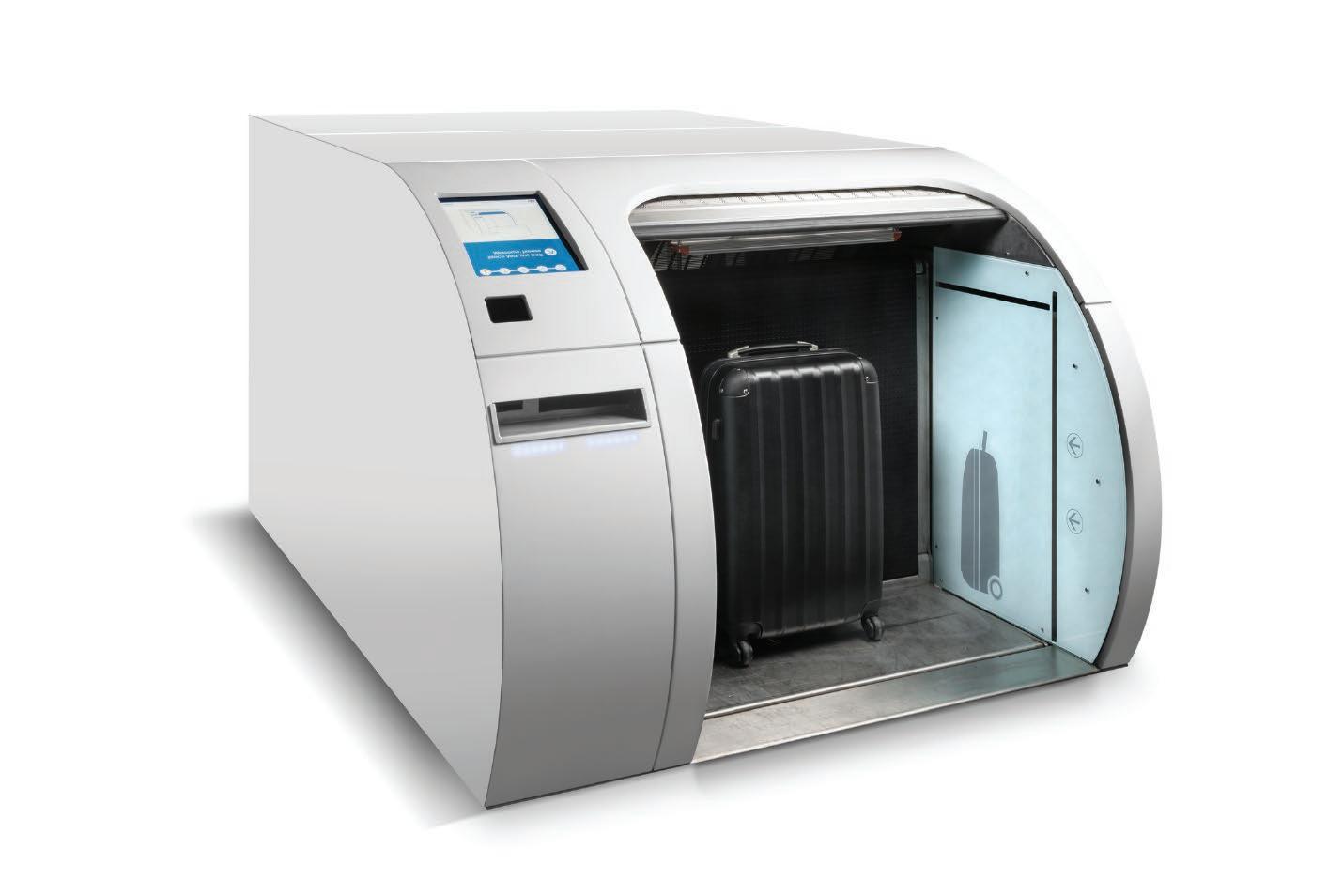
Secondly, the Scarabee Security Lane considers passengers travelling in groups and clinging together. The key innovation of Security as a Service is enabling parallel passenger processing in parts of the process such as divestment, security scan and reclaim. It challenges the traditional ‘first come first service’ approach. This is a huge breakthrough
The Scarabee Security Lane has proven to be a success. Amsterdam Airport Schiphol received the Best Airport Security Initiative Award 2014 for the installed SSL. By the end of 2015 in total sixty-five new security checkpoints will be deployed at Amsterdam Airport Schiphol.
Co-Creating Unlimited Possibilities
In order for airports, airlines and stakeholders to achieve their actual potential, co-creation forms an important element in the process of reducing bottlenecks. It encourages looking beyond the obvious airport solutions to meet future development needs.
IMPROVING THE PASSENGER EXPERIENCE AND THE ROLE OF ADVANCED AIRPORT AND AIRLINE HANDLING SYSTEMS WWW.GLOBALBUSINESSMEDIA.ORG | 5
“You should take a look at Amsterdam Airport Schiphol where Scarabee invented a new way to accelerate the flow at the the security check-in.
This is amazing.”
Hans de Boer (2014) | Chairman of The Confederation of Netherlands Industry and Employers
BAG DROP
Knowing that the security checkpoint is one of the most stressful stages in a passenger’s journey, security procedures should be quick, easy and passenger-friendly
“We are setting a new standard for aviation security by transforming it from a frustrating chore to a pleasant service. It is already partially operational and the feedback from users –both security staff and passengers –is unanimously positive.”
Jos Nijhuis (2014) | CEO Amsterdam Airport Schiphol referring to the newly developed Security Checkpoint
The International Air Transport Association (IATA) shows a strong passenger growth of thirty-one percent between 2012 and 2017. Determining the resources and a joint discussion on capabilities and requirements makes it possible to tackle challenges effectively. Co-creation is the process in which several options emerge to become the ultimate custom made solution.
Security Experience Centre
Scarabee’s Security Experience Centre (SEC) is located in Hoofddorp in The Netherlands. This facility provides the opportunity for Airports and Airlines to get acquainted with Scarabee, its partners and passenger-centric solutions.
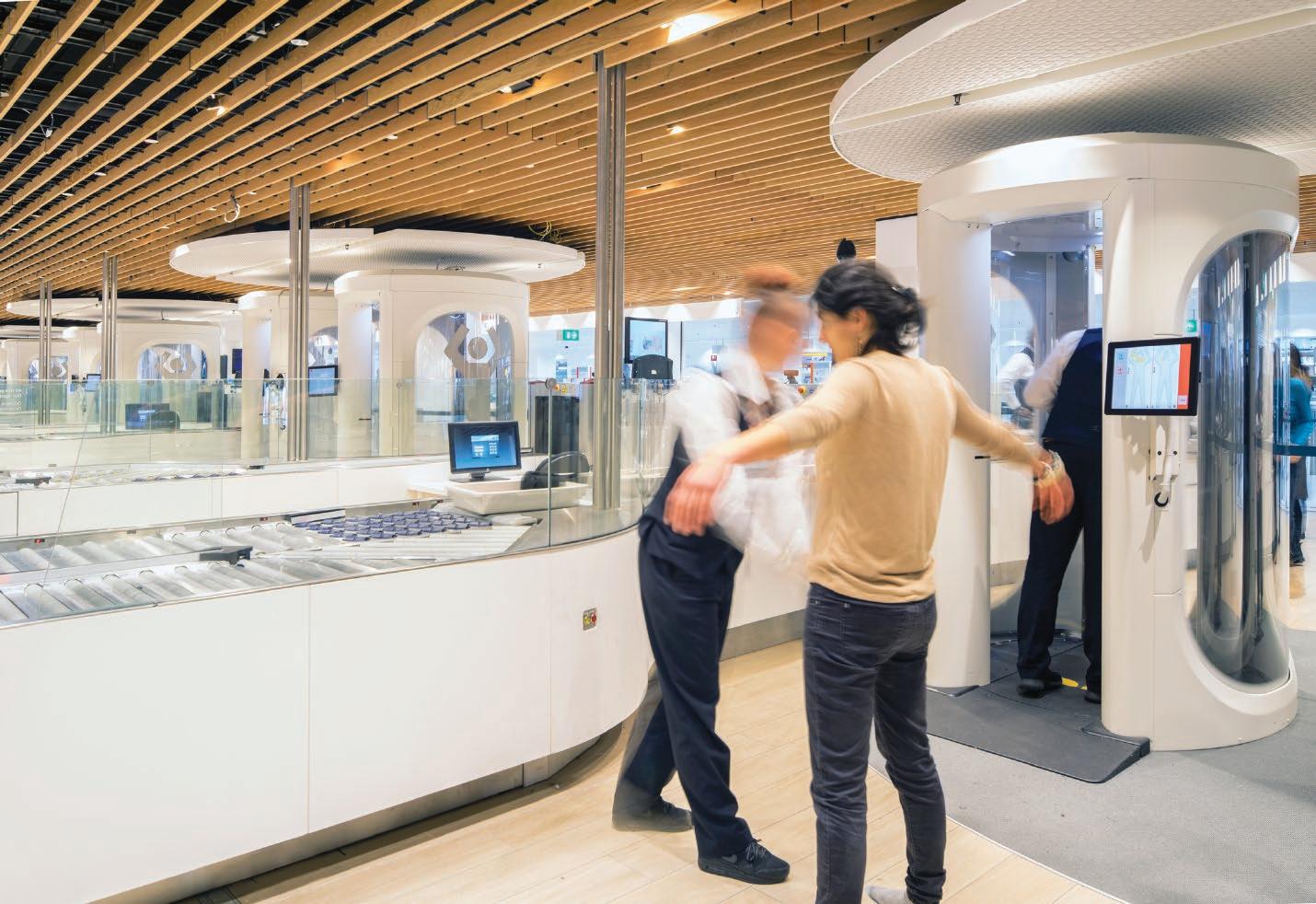
At Scarabee, SEC new airport security concepts and solutions are tested within the framework of Security as a Service and Smart Security. Scarabee SEC offers insight in several approaches to translate specific needs into adequate solutions - to discover the future
of airports and airlines by offering instant and adequate solutions adaptable to evolving changes in regulatory requirements.
In 2014, the existing Scarabee SEC doubled to 6.000 m2 offering more space and facilities to test new large-scale concepts, implement pilot studies and extend and improve the Scarabee security training services.
Handling the Future Of Aviation
All of Scarabee’s systems, applications and technologies have been designed with the passenger’s comfort in mind: no queues, no stress and improving flow and throughput. Scarabee continues to develop and implement innovative and smart airport solutions. Our goal is to improve the dynamics, productivity and ambiance of airports worldwide and to exceed the expectations of both passengers and the aviation industry – Michael Tan, CEO
Contact Headquarters
Haringvliet 100, P.O. Box 23142 3001 KC Rotterdam, The Netherlands

Schiphol Airport
Schiphol Boulevard 277 1118 BH Schiphol Airport
The Netherlands
Security Experience Centre
Avio Trade Park, Hoeksteen 131 2132 MX Hoofddorp, The Netherlands
Middle East Office
Churchill Executive Tower, Business Bay No. 3616
Dubai | UAE
IMPROVING THE PASSENGER EXPERIENCE AND THE ROLE OF ADVANCED AIRPORT AND AIRLINE HANDLING SYSTEMS 6 | WWW.GLOBALBUSINESSMEDIA.ORG
We offer unique Airport Solutions through close cooperation with airports, airlines and stakeholders.
Sharing insights and perceptions makes it possible to effectively anticipate and respond to future security challenges, improve airport productivity and maintain a high passengerfriendly ambience.
This is the power of co-creation
SECURITY CHECKPOINT SCREENING
References:
1 ATAG (2014). Facts & Figures. [online] Available at http://www.atag.org/facts-and-figures.html.
2 Ibid.
3 ACI (2014). “Guidelines for Passenger Services at European Airports: The Passenger at the Heart of the Airport Business.” Brussel: ACI EUROPE.
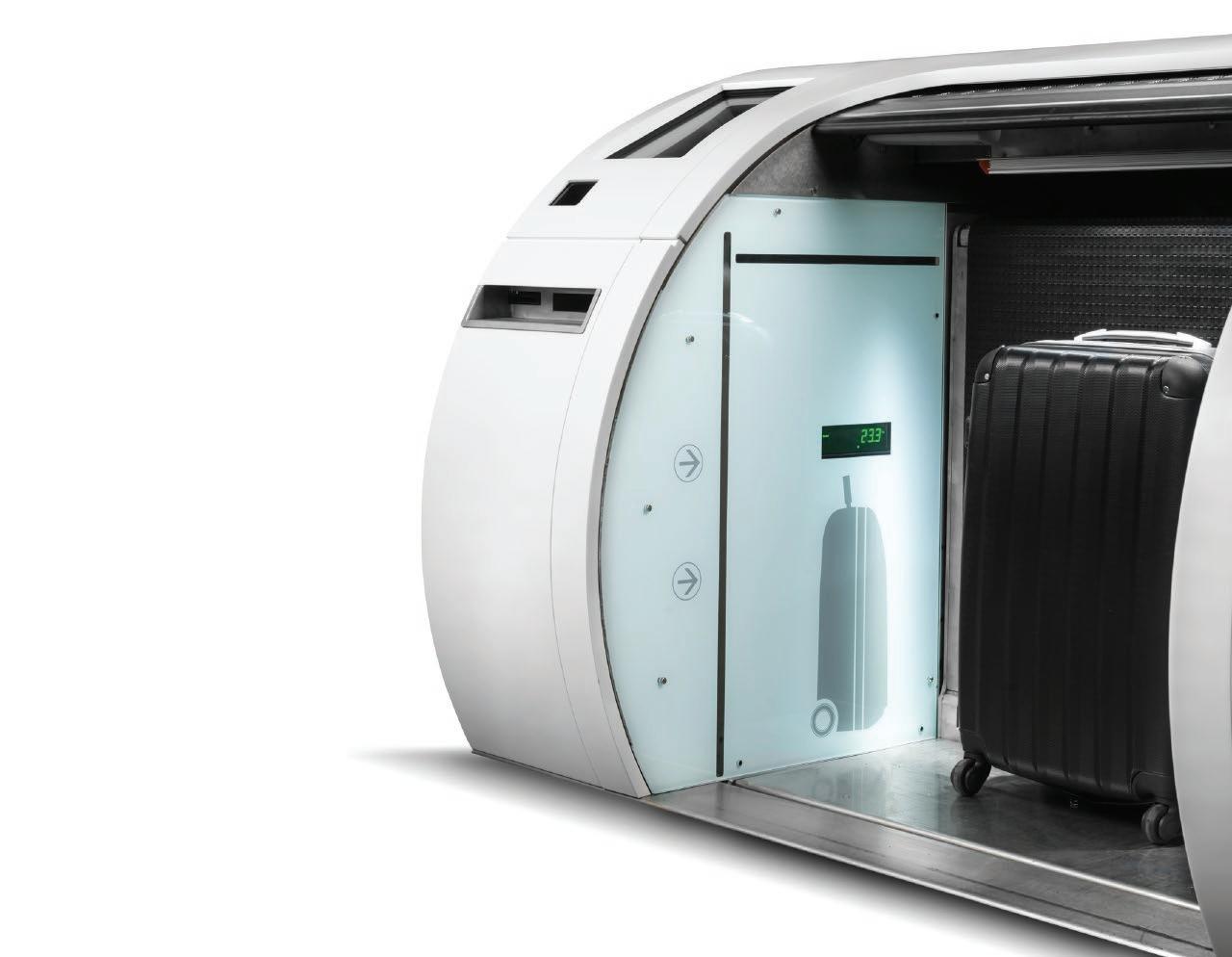
4 RedOrbit (2011). Four Million Britons Give up Flying Due to Airport Stress. [online] Available at http://www.redorbit.com/news/business.
5 Tsamboulas, D.A. and Nikoleris, A. (2008). “Passengers’ Willingness to Pay for Airport Ground Access Time Savings.” Transportation Research Part A: Policy and Practice. Vol. 42(10), pp. 1274-1282.
6 Capgemini Consulting (2014). Customer Experience. [online] Available at http://www.capgemini-consulting.com/.
IMPROVING THE PASSENGER EXPERIENCE AND THE ROLE OF ADVANCED AIRPORT AND AIRLINE HANDLING SYSTEMS WWW.GLOBALBUSINESSMEDIA.ORG | 7
BAGDROP G8 MODULAR COMPACT UNIT SIDE
Scarabee keeps in mind that families and travel groups can slow down the process and cause long queues
Winning the Battle Against Lost Luggage
Tom Cropper, Editor
THE RATE at which passengers’ luggage was lost used to be a source of considerable embarrassment. Today thanks to a concerted push by airports and airlines, it is fast becoming something to be proud of. Despite rising passenger numbers, airlines have reversed a rising trend in the numbers of lost bags. In this article, we look at how they have done it.
Every airport contains a hidden world. Unseen by the majority of passenger, miles of conveyor belts, storage, sorting and screening facilities transport passengers’ bags from the checkin desk to the aircraft and (all being well) back to the correct carrousel at the correct airport. It is an enormous operation – every day tens of thousands of passengers board hundreds of flights depositing millions of bags over the course of a year. Given these statistics, it’s no surprise that the aviation industry has been waging an ongoing war against its old menace of lost luggage.
A few years ago it looked like this was a battle the industry was losing. According to SITA’ which tracks aviation baggage handling performance, lost bags were costing the industry $4bn a year in 2007. Instances of lost bags had been rising steadily year on year and had become a serious point of embarrassment, as well as cost, for airlines. Around 19 bags per thousand customers were going missing, each of which cost on average $1001 to repatriate. Today, though, it is a different story. SITA’s most recent figures show that the rate of lost bags has plummeted to 6.96 per thousand customers. So what has made the difference?
Some of the changes are relatively simple. Communication has improved between airlines, which helps for bags making transfers between fights. Overall punctuality has improved, which eases the pressure on baggage handling staff, while basic technology such as hand-held scanners, have become more sophisticated and, in particular, robust. Today’s models are
less likely to break when dropped on the ground. A real turning point, though, seems to have been when airlines started to charge for customers’ bags. Firstly, this prompted a change in customer behaviour with passengers choosing to leave excess luggage at home rather than pay the surplus. Airlines too came under pressure. Considering they were now paying for their bags to be transported, passengers’ expectations rose. Lost bags now became an even more painful point when they went missing. For airlines, baggage claims also became a revenue driver which meant they could now justify investment in procedures and technologies and systems which could reduce the number of bags which went missing every year.
Upgrading the System
One airport which has been investing heavily in change is Heathrow. Back in 2008 its record in the new Terminal 5 was shocking. Reports highlighted that the airport was losing 900 bags for transferring passengers each day. Passengers had a one in 12 chance of losing their luggage2. It was one of a series of embarrassing stories for the airport during what was a troubled opening for the new terminal. Since then they have developed one of the most complex and sophisticated baggage handling systems in the world. In a bid to reduce their high missing bag statistics, BAA invested £900milion into upgrading processes and technology all around the airport, which included the creation of tunnels interlinking the various terminals. These, believed the airport managers, were crucial in reducing waiting times and overcoming many of their problems. The result is one of the largest automated baggage handling systems in Europe which can process up to 150,000 items of luggage each and every day.
Such major upgrades are expensive but necessary given the future demands expected
IMPROVING THE PASSENGER EXPERIENCE AND THE ROLE OF ADVANCED AIRPORT AND AIRLINE HANDLING SYSTEMS 8 | WWW.GLOBALBUSINESSMEDIA.ORG
How airlines have been winning the ongoing battle against lost luggage
SITA’s most recent figures show that the rate of lost bags has plummeted to 6.96 per thousand customers
to be inflicted on airports. Even overhauling an existing system represents a significant risk and can create problems as well as drive benefits. For this reason, airport operators are investing heavily in test and simulation tools which can ensure any new functions coming in are up to the job.
For Schiphol Airport in Amsterdam, for example, testing and simulation was crucial in helping them assess the performance of a new baggage handling system designed to cope with an expected capacity increase from 40 million to 70 million items of luggage every year. Working closely with Scarabee, they implemented a strategic tool which could test new software and hardware before it was deployed. The technology allows Schiphol to stress test the system in advance under a series of ‘what if’ scenarios to identify how it will perform under a range of different situations. Thanks in part to the testing platform, the implementation of the new software has been an enormous success driving a 50% decrease in lost luggage in the space of three years.

New Technology
As ever, new technology has played an important part. Airports have become much more adept at gathering accurate data from passengers and, crucially, communicating this to baggage
handlers. They will now have a precise and accurate idea of how many bags are expected for each flight. They can count them in and count them out, ensuring the numbers match before departure. Sophisticated software can enable airports to monitor the flow of bags through the system, locating lost bags and providing an early warning alarm if the system is reaching capacity. These and other systems are placing a huge amount of data at operators’ fingertips allowing them to track bags more efficiently and identify problems long before they occur.
Given the nadir the industry reached back in 2007, it has made considerable strides in the past seven years, with an overall reduction in missing baggage of approximately 50%. However much of this has come in low hanging fruit –procedural changes, better communication between airports, and a reduction in the number of bags per customer. With luggage now considered a source of revenue by airlines, their attention has finally swung around to what was historically a much neglected area of their operations. The progress made so far is considerable, but will not be enough to satisfy passengers who increasingly expect the best in all aspects of their passenger experience. For this reason, further progress in the future will need to be driven by new and more sophisticated technologies.
IMPROVING THE PASSENGER EXPERIENCE AND THE ROLE OF ADVANCED AIRPORT AND AIRLINE HANDLING SYSTEMS WWW.GLOBALBUSINESSMEDIA.ORG | 9
For this reason, airport operators are investing heavily in test and simulation tools which can ensure any new functions coming in are up to the job
The Battle for a Less Stressful Passenger
James Butler, Staff Writer
AIR TRAVEL used to be something passengers had to put up with – a final indignity to be endured before the holiday began. But increased competition and rising expectations are placing pressure on the operators of airports to take measures which can improve the experience of people while they are in the terminal. To do this they are turning to a heady mixture of technology and psychological warfare.
The Importance of Stress
According SITA’s 2014 IT Airport Survey3, airports are spending around $6bn dollars globally on IT infrastructure, with the aim of making the lives of customers as they pass through the terminal easier. According to the survey, 70% of respondents said that improving customer experience was at the heart of their strategy with ideas such as self-service check-ins and mobile phone applications being particularly popular.
Airports are placing a huge importance on technology, which can aid the customer experience, which is why expenditure here is rising considerably faster than overall revenue. Competition has grown with the majority of people having more than one major international airport to choose from when making any single journey. People have also shown a willingness to switch airports if they believe the experience will be better elsewhere. As such, the question of how happy and content passengers feel has become a priority. A major part of this involves reducing the stress and anxiety passengers feel as they pass through their airport terminals –and much of that stems from the length of time they are forced to wait.
According to another SITA survey – this time relating to passenger self-service, loss of time (44%) – and in particular the fear of missing a flight – was the number one cause of stress at airports. Other top responses included a lack of control and information. Addressing these
concerns can improve customer satisfaction and improve their overall impression of the airport. Doing so, however, is far from simple. Ever increasing demands of security, as well as growing passenger volumes, place a huge strain on check-in staff which means operators are having to think out of the box and deploy innovative solutions to keep stress levels in check, such as managing expectations, providing more information and of course, reducing their overall waiting times.
The Psychology of Queuing
On average, people over-estimate the amount of time they spend in line by around 36 percent. The implication is that it’s not necessarily the length of the wait which is the issue – it’s the experience while waiting. A good example can be found in a New York Times article that reflects on the experience of Houston Airport which received numerous complaints about the inordinate amount of time people were waiting at baggage reclaim. They took the obvious steps of deploying more staff to the area, which cut waiting times to around eight minutes. However, the complaints continued at the same pace, so they looked at what passengers were doing during their wait and found that it consisted of approximately one minute walking to baggage reclaim and the remaining seven waiting around. Their response was to lengthen the amount of time people spent walking to the carousel. Although waiting times remains the same, passengers’ perception of the wait changed significantly. The result – complaints all but vanished4
Queuing psychology is crucial in reducing stress and is far from a new phenomenon. After the war it was discovered that mirrors placed next to long escalators helped people endure the wait by giving them something to look at while they were travelling – namely themselves. Advertisers have also cottoned onto this, plastering the walls with posters, in
IMPROVING THE PASSENGER EXPERIENCE AND THE ROLE OF ADVANCED AIRPORT AND AIRLINE HANDLING SYSTEMS 10 | WWW.GLOBALBUSINESSMEDIA.ORG
How major airports are using technology and mind games to improve the passenger’s travel experience.
According to the survey, 70% of respondents said that improving customer experience was at the heart of their strategy
the attempt to persuade people to spend this dead time buying more things.
Most of all, perception is controlled by expectations. A major cause of stress when stuck in a line is the fact that you do not know how long you will be waiting. One method of addressing this issue can be seen at Austin Bergstrom International Airport5 which uses Bluetooth and WIFI signals from mobile phones to count how many people are passing through security. The system does not capture any personal information about passengers –it simply tracks their progress and uses this information to give passengers entering the hall an accurate estimate about how long they can expect to be. A twist on this can be called the so called Disney World approach. They understood that if people waited in line for less time than they expected they would leave with a more favourable view. Their response was simple – to over-estimated the expected waiting times. Therefore, when you arrive at your ride ahead of schedule, you feel pleasantly surprise.
Gaining Control
Another method of eliminating stress is to give passengers much more control over their own journey. Key to this are self-service applications. Already, two thirds of passengers use options such as self-service check-ins and there is plenty of enthusiasm for more. This is being facilitated by the rising use of smartphones, with around 70% of passengers now owning one. This creates numerous opportunities to devolve more power to the people. 90% of passengers want more flight information and self-boarding products, both of which can be delivered through smartphones.

Amsterdam Airport Schiphol6 has been a pioneer in self service options. Online checkin and automatic check-in through kiosks have long been available as they have been elsewhere in the world. However, in 2008 the airport began supplementing these options with self-service baggage drops. These are extremely easy to use. Passengers scan their barcode from their paper boarding pass or the internet boarding pass on their mobile phone, the machine then prints a label which they can attach themselves before placing the bag on the conveyor belt. The system works not only by reducing the need to queue for baggage drop at check-in desks but also because it gives passengers more control over their journey. They can supply the information themselves and check that it’s correct, adding to the sense of reassurance that the bag will get to where it is intended.
Solutions such as these work not only because they can reduce the amount of time people spend waiting but because they can improve the overall experience while people wait. Feeling out of control, uninformed and at the mercy of processes they do not understand or see the need for are major contributors to stress, leaving passengers with a negative view of an airport. By making the process more transparent, passengers can see what is happening, they can form expectations about the amount of time they will spend in the airport and also take matters into their own hands. All this contributes to a less stressful and more content passenger. Even so, an even greater contributor to the experience requires a measurable reduction in the amount of time people spend waiting, and that is the theme of the next article in the Report.
IMPROVING THE PASSENGER EXPERIENCE AND THE ROLE OF ADVANCED AIRPORT AND AIRLINE HANDLING SYSTEMS WWW.GLOBALBUSINESSMEDIA.ORG | 11
Solutions such as these work not only because they can reduce the amount of time people spend waiting but because they can improve the overall experience while people wait
Reducing the Wait
Jo Roth, Staff Writer
WHEN PASSENGERS think about the experience of travelling through an airport, their major concern is the amount of time they will be waiting. Whether it’s waiting to check in, go through security or collect their baggage, the uncertainty of how much time they’ll spend in a line is a major cause of stress. In days gone by, they may have been forced to accept the wait as part of the price they pay for going on holiday. But today the majority of customers have the choice of at least two major international airports, and have shown a willingness to choose one over the other if they believe their experience is likely to be more worthwhile. Reducing waiting times has therefore become a business priority for major airports and airlines respectively, which is why they are coming up with innovative solutions to address the problem. Some of these are based on the latest technology while others simply require a different strategic outlook.
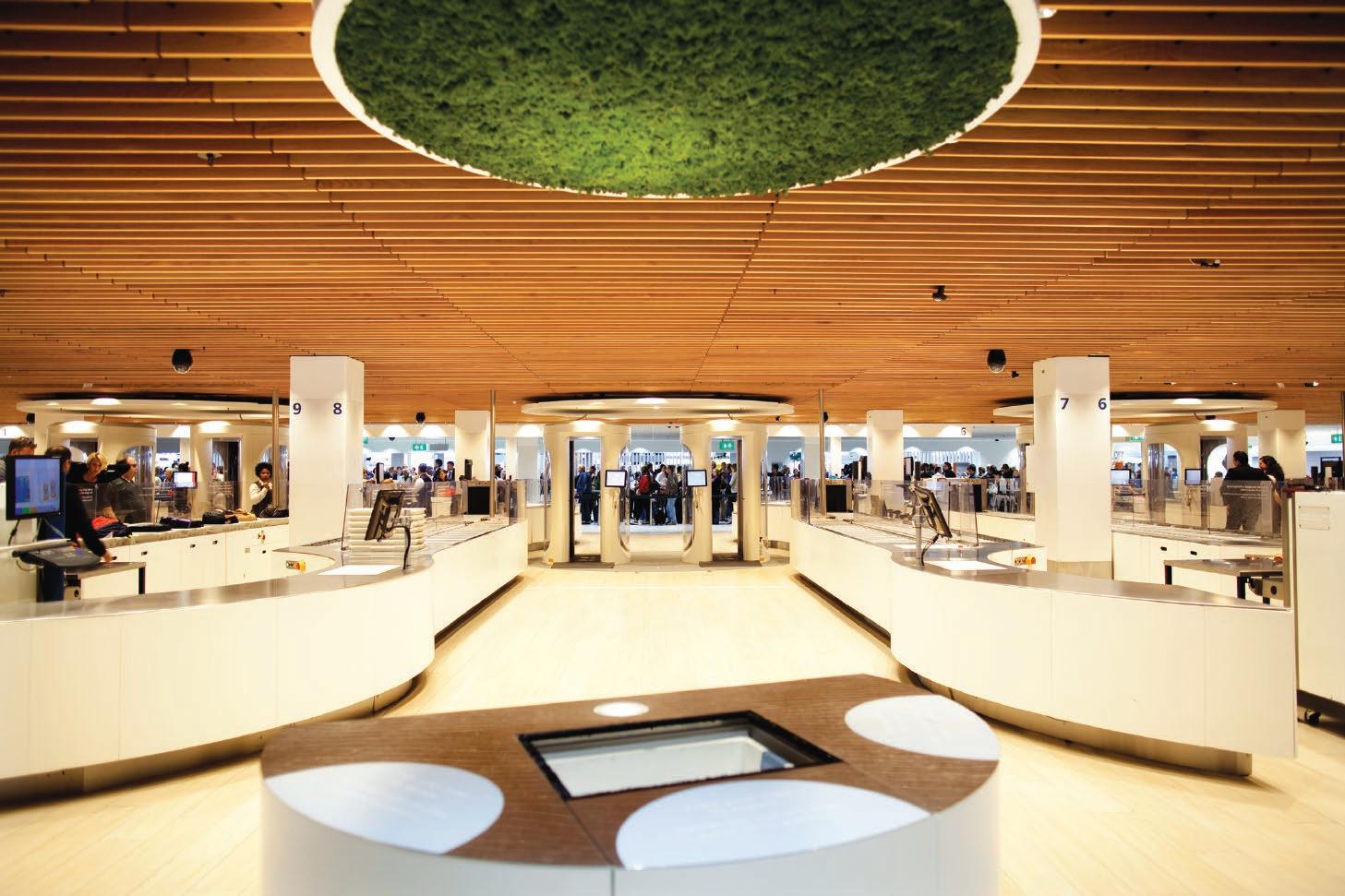
The Challenge
Reducing the length of queues at key bottle necks is no easy challenge. Security requirements have become stricter ever since 9/11 while passenger numbers are increasing all the time. According to the Civil Aviation Authority, UK airports handled 228 million people in 2013, an increase
of 7.8million (3.8%) over 20127. It represents the third year in a row numbers have risen as business recovers towards pre-recession levels. At the same time, the imposition of arduous security checks can make passing through airport terminals a major ordeal.
According to a study conducted by a research scientist, the stress levels experienced by passengers is on a par with fighter pilots and riot police. Numerous customer satisfaction surveys cite waiting times and concern about being late as the top priorities, while passengers also show frustration with what they see as unnecessary procedures. Writing in the Telegraph, Nigel Richardson recounted the story of Newsnight presenter Emily Maitless who was questioned by Special Branch after what’s described as traces of an explosive substance (probably hand cream) were found on her hand baggage8
Passengers can become even more angered by apparent attempts by some airports to monetise these waiting lines. Some, such as Bristol Airport, charge for the use of a dedicated security channel, while others have been found to charge for transparent plastic bags into which any fluids can be disposed. Measures such as these are seen as profiteering and do little to lighten the mood of passengers. To lighten the strain, therefore, airports are bringing in
IMPROVING THE PASSENGER EXPERIENCE AND THE ROLE OF ADVANCED AIRPORT AND AIRLINE HANDLING SYSTEMS 12 | WWW.GLOBALBUSINESSMEDIA.ORG
Reducing waiting times has therefore become a business priority for major airports and airlines
How airport operators are developing new ways to bring down the length of time people wait in line.
SECURITY CHECKPOINT AIRPORT SCHIPHOL BACK OVERVIEW
new innovations which can reduce queue length without further infuriating their already stressed passengers.
Baggage Handling
One obvious way to reduce waiting times is to eliminate time-consuming procedures wherever possible. Security checks may be a necessary evil, but it is possible to reduce the amount of time passengers spend checking in their bags. Earlier in this Report we have already looked at the example of Amsterdam Airport Schiphol where automated baggage checkin drops have helped to avoid time at checkin. British Airways is currently developing and trialling electronic bag tags. Once checked in, customers can synchronise their tag with their smartphone, which eliminates the need to have a new paper tag printed and saves precious minutes at check-in.
“This is a fantastically simple, yet smart device that gives each customer the choice to have their own personalised electronic baggage tag that changes with the swipe of a smartphone – every time they fly,” said Frank Van der Post, British Airways’ managing director for brands and customer experience. “As the saying goes, ‘good things come in small packages’, and this innovative device is no exception. Along with other initiatives we are investing in, we believe it has the potential to revolutionise the way our customers check in and pass through every airport around the world in the future.”
Home printed bag tags also have potential. Iberia’s My Bag Tag scheme recently won the Future Travel Experience Award9 for best check-in initiative. It allows customers to print out a bag tag at home and fix it to their luggage. This can then be deposited at a dedicated counter on their arrival. Again it reduces check-in waiting times and means less time carting baggage around the airport.
Another innovation is looking to eliminate the need to carry bags even as you arrive. Airportr is a baggage collection and delivery service which makes travelling a much lighter and easier proposition. Passengers can book online and arrange to have their bags picked up at an agreed time from their home by an Airportr representative.
If passengers are travelling from a hotel they can simply leave their bags with the concierge and have them picked up. They then deliver the bags to the terminal allowing you to track your baggage all the way via GPS. The idea is that you can travel to and from the airport without the need to carry bags and they will be there waiting for you when you check in at the airport.
On top of this, British Airways is investing heavily in other innovations such as self-service checkins and automated processes. These not only help to reduce the length of the queues, but they demonstrate to passengers an eagerness to take all the steps possible to improve their experience and to eliminate needless and irritating additional delays.
Taken together, these initiatives aim to drive benefits by creating a series of marginal and incremental improvements. A permanent tag which can be scanned as opposed to a paper tag which needs to be printed and fitted may only save a minute or so. But with other efficiency improvements, it can slightly reduce the time taken for each different passenger, and with thousands of people passing through check-in every day, that can amount to a significant reduction in overall queue length and waiting times. In this way, airport operators are hoping that the customer satisfaction surveys passengers are occasionally presented with when entering the arrivals lounge will start to bring better news.
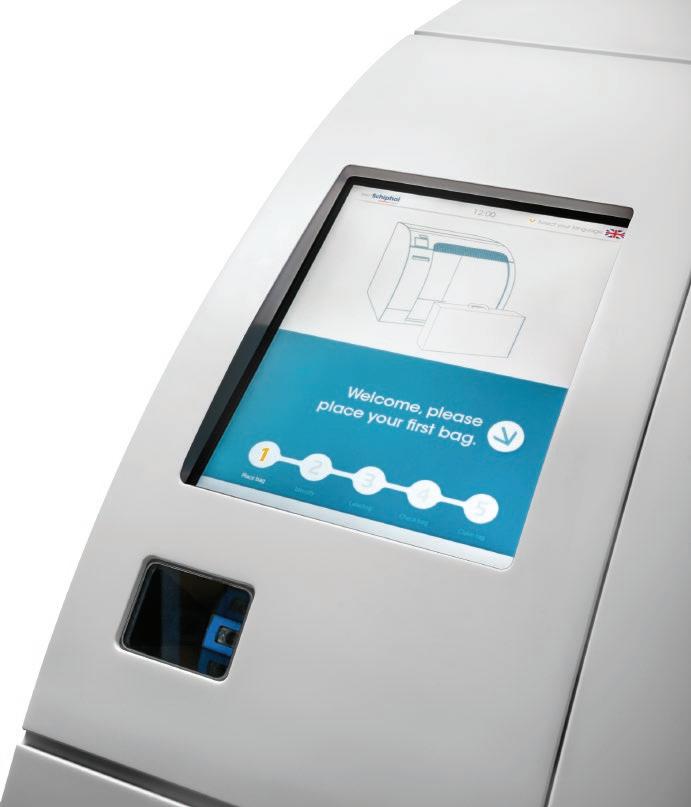
IMPROVING THE PASSENGER EXPERIENCE AND THE ROLE OF ADVANCED AIRPORT AND AIRLINE HANDLING SYSTEMS WWW.GLOBALBUSINESSMEDIA.ORG | 13
BAGDROP G8 MODULAR COMPACT SCREEN
Taken together, these initiatives aim to drive benefits by creating a series of marginal and incremental improvements
The Future of Baggage and People Management
Tom Cropper, Editor
Baggage and people management systems and software has evolved considerably in the last few years, but what does the future hold.
WELCOME TO the smart airport of the future. Here technology is infused throughout the building. Some of it you can see, such as automated check-in, self-service bag drops or virtual assistants; others are hidden behind the scenes in the form of IT, people management software and queue forecasting equipment. These have already had considerable success in bringing down waiting times, but if latest projects around the world are anything to go by, this is only the beginning.
Where We Are Now
Technology has already played an important role in the improvement of customer services within airports. Automated and online check-in services have helped to counteract the effect of added security processes. Fewer bags are now lost and most passengers say they are now satisfied with their experience. However, there is still much to do – complaints remain a problem and we are still a long way from the experience of air travel being considered anything more than an ordeal which is to be endured. Statistics show that most people only feel their holiday has begun once they leave the airport. So what can be done to bring about continued improvements and to address remaining concerns?
The Airport as a Destination
Most modern airports were built during the sixties, coping with an unprecedented explosion in air traffic as people moved from propeller planes to mass transport jets. As a result, they came to be functional and dour – built for purpose rather than experience.
The new theme in design is to return a special sense of place into the airport. Madrid’s Baraja Airport, for example, won the prestigious Stirling Prize in 200610, while Indianapolis has been praised for its cutting edge design, efficient organisation and low waiting times. This design
focuses on transforming airports into places that are comfortable and enjoyable to be in – places which enhance rather than detract from the overall experience.
Part of this is cosmetic, with modern designers eager to create hubs which are indicative of the places in which they are located, but a big part is also functional. Checking in and passing through security should be as easy as possible. Both Indianapolis and Madrid are marked by their open feel glass walls and high ceilings. There is a sense that passengers can see where they are and where they are going. Explaining the concept to Citylab.com Robert Chicas, an architect for HOK said: “You see what’s coming, and there’s a sense of orientation. Indy is a case study in that. If passengers know where they are, and know where they’re going, it helps relieve the anxiety of the whole experience.”11
Aesthetics, therefore, can play a key role, but what’s more remarkable are some of the technological innovations which are driving practical improvements.
Virtual Assistant
Among the most striking are the virtual hologramatic customer service assistants at places such as Dubai and Athens. These project a holographic customer service assistant who can answer questions and direct passengers in a variety of different language. They have been programmed to interact as much as possible with passengers and answer the most common questions asked.
In so doing, they can make it easier to access information and directions while also reducing crowding at help desks. It’s all about giving people access to the information they need in the shortest possible amount of time. Even so, this kind of technology can be as controversial as it is helpful. As tech savvy as passengers have become, they still prefer human contact and it’s easy to distrust automated responses.
IMPROVING THE PASSENGER EXPERIENCE AND THE ROLE OF ADVANCED AIRPORT AND AIRLINE HANDLING SYSTEMS 14 | WWW.GLOBALBUSINESSMEDIA.ORG
Fewer bags are now lost and most passengers say they are now satisfied with their experience
Smart Technology
Another area of potential controversy is in the use of smartphones in the terminal. With usage having risen rapidly over the last few years, making use of them is an obvious step for airports. However, it’s the way in which this data is used that is sensitive.
Customers respond positively to ideas which involve an opt-in app which allows them to receive notifications and information about their departure. Using this technology, airports can alert people when they are in the wrong place and notify them about any changes to their flight schedules.
Airports such as Copenhagen have been trialling schemes which allow them to track passengers through the airport via their mobile phone signals. The intention is to supply information about passenger flow throughout the terminal, enabling airports to adjust working practices and deploy staff in the right areas, which can help them to reduce bottlenecks and plan for busy times. However, the amount of information available is immense and that same technology can be used to see what areas of the retail facility people visit and what they buy. This information can be used to boost the performance of an airport’s retail arm, which is becoming an increasingly valuable part of overall revenue, but passengers tend to be uncomfortable with sharing that level of personal information and do not trust the way in which it will be used. The solution to this, therefore, is systems which can provide increasingly accurate and up to date information about people movement, but which protect privacy at the same time.
These state of the art systems can use thermal imaging cameras which track shapes creating a 3D chart. They enable airports to measure accurately the number of people passing through any particular area without capturing any images or personal information, thereby providing the reassurance passengers are looking for.
Airports have long been counting people in some way, but what’s changing is the use of highly advanced flow management systems which can take that data and provide real time updates about the situation on the ground. This, in turn, can identify when bottlenecks occur allowing airports to move staff to affected areas to resolve the problem.
One example is the Scarabee Passenger Flow System that uses an integrated system of cameras linked to software which monitors passenger flow. When it increases it can trigger an alert which allows the airport to deploy additional staff to manage the situation. This can, in turn, be linked to what they call their Airport Performance Dashboard which can be used to identify the flow of baggage coming through certain areas. It can measure when load is reaching capacity and alert staff when bottlenecks occur. What’s more, the ability to track bag movements means they can identify when a bag is in the wrong place, and ensure it is re-routed to the correct destination.
Eye to the Future
Real time information such as this is driving continuous advancements in crowd management technologies. However, an intriguing look to the future can be seen at Narita Airport in Japan where non-stop biometric security gates are being trialled. The system used cameras with facial recognition technologies together with hazardous material sensors to identify passengers without the need to stop. If successful, trials such as these promise sizable reductions in the most time-consuming security procedures.
Developments, therefore, are coming quickly and the airport of the future will look very different from what we recognise today. It is a place where function will be blended with aesthetics; where delays will be minimised and bottlenecks eradicated. In short, the end goal is to make air travel a pleasure once again.
IMPROVING THE PASSENGER EXPERIENCE AND THE ROLE OF ADVANCED AIRPORT AND AIRLINE HANDLING SYSTEMS WWW.GLOBALBUSINESSMEDIA.ORG | 15
As tech savvy as passengers have become, they still prefer human contact and it’s easy to distrust automated responses
References:
1 Airline bag delivery hits all time high: http://www.sita.aero/content/Airline-bag-delivery-hits-all-time-high
2 Terminal 5 Still losing 900 bags per day: http://www.theguardian.com/business/2008/jul/10/britishairwaysbusiness.heathrow
3 Airline IT trends 2014: http://www.sita.aero/surveys-reports/industry-surveys-reports/airline-it-trends-survey-2014
4 Why waiting in line is torture: http://www.nytimes.com/2012/08/19/opinion/sunday/why-waiting-in-line-is-torture.html?pagewanted=all&_r=2&
5 Austin’s Airport uses WIFI to gauge how long you’ll wait: http://www.engadget.com/2014/10/26/austin-airport-wifi-security-line-estimates/
6 Is self service bag drop the future of baggage processing:
http://www.futuretravelexperience.com/2011/08/is-self-service-bag-drop-the-future-of-baggage-processing/
7 Passenger numbers at UK airports increase for third year in a row:
http://www.caa.co.uk/application.aspx?appid=7&mode=detail&nid=2342
8 Civil Aviation Authority: http://www.caa.co.uk/application.aspx?appid=7&mode=detail&nid=2342
9 My Bag Tag: http://www.iberia.com/web/obsmenu.do?menuId=MYBAGTAG
10 Airport scoops architecture prize: http://news.bbc.co.uk/1/hi/uk/6050836.stm
11 The next generation airport is a destination in its own right: http://www.citylab.com/design/2014/08/the-next-generation-airport-is-a-destination-in-its-own-right/379043/
IMPROVING THE PASSENGER EXPERIENCE AND THE ROLE OF ADVANCED AIRPORT AND AIRLINE HANDLING SYSTEMS 16 | WWW.GLOBALBUSINESSMEDIA.ORG
Visit: www.primarycarereports.co.uk

















